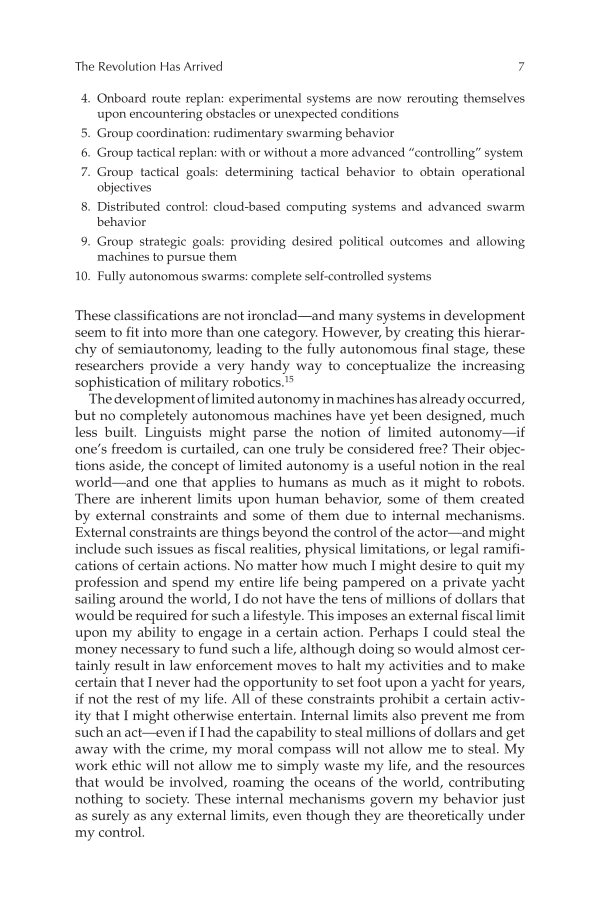The Revolution Has Arrived 7 4. Onboard route replan: experimental systems are now rerouting themselves upon encountering obstacles or unexpected conditions 5. Group coordination: rudimentary swarming behavior 6. Group tactical replan: with or without a more advanced “controlling” system 7. Group tactical goals: determining tactical behavior to obtain operational objectives 8. Distributed control: cloud-based computing systems and advanced swarm behavior 9. Group strategic goals: providing desired political outcomes and allowing machines to pursue them 10. Fully autonomous swarms: complete self-controlled systems These classifications are not ironclad—and many systems in development seem to fit into more than one category. However, by creating this hierar- chy of semiautonomy, leading to the fully autonomous final stage, these researchers provide a very handy way to conceptualize the increasing sophistication of military robotics.15 The development of limited autonomy in machines has already occurred, but no completely autonomous machines have yet been designed, much less built. Linguists might parse the notion of limited autonomy—if one’s freedom is curtailed, can one truly be considered free? Their objec- tions aside, the concept of limited autonomy is a useful notion in the real world—and one that applies to humans as much as it might to robots. There are inherent limits upon human behavior, some of them created by external constraints and some of them due to internal mechanisms. External constraints are things beyond the control of the actor—and might include such issues as fiscal realities, physical limitations, or legal ramifi- cations of certain actions. No matter how much I might desire to quit my profession and spend my entire life being pampered on a private yacht sailing around the world, I do not have the tens of millions of dollars that would be required for such a lifestyle. This imposes an external fiscal limit upon my ability to engage in a certain action. Perhaps I could steal the money necessary to fund such a life, although doing so would almost cer- tainly result in law enforcement moves to halt my activities and to make certain that I never had the opportunity to set foot upon a yacht for years, if not the rest of my life. All of these constraints prohibit a certain activ- ity that I might otherwise entertain. Internal limits also prevent me from such an act—even if I had the capability to steal millions of dollars and get away with the crime, my moral compass will not allow me to steal. My work ethic will not allow me to simply waste my life, and the resources that would be involved, roaming the oceans of the world, contributing nothing to society. These internal mechanisms govern my behavior just as surely as any external limits, even though they are theoretically under my control.
Document Details My Account Print multiple pages
Print
You have printed 0 times in the last 24 hours.
Your print count will reset on at .
You may print 0 more time(s) before then.
You may print a maximum of 0 pages at a time.
























































































































































































































































































